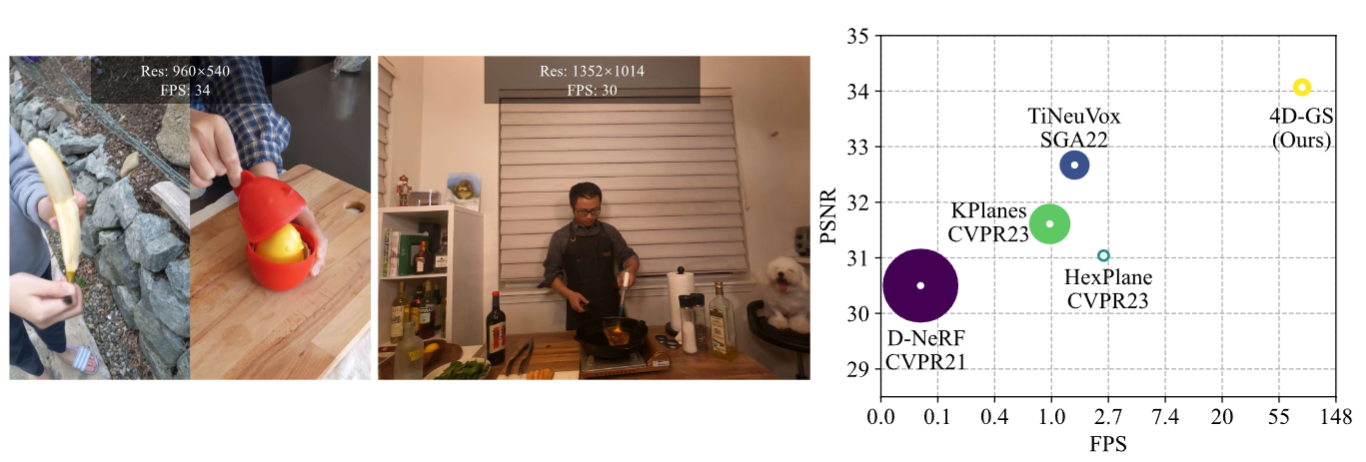Guanjun Wu 1*, Taoran Yi 2*,
Jiemin Fang 3‡, Lingxi Xie 3 ,
Xiaopeng Zhang 3 , Wei Wei 1 ,Wenyu Liu 2 , Qi Tian 3 , Xinggang Wang 2‡✉
1 School of CS, HUST 2 School of EIC, HUST 3 Huawei Inc.
* Equal Contributions.
 Our method converges very quickly and achieves real-time rendering speed.
Our method converges very quickly and achieves real-time rendering speed.
New Colab demo: (Thanks Tasmay-Tibrewal
)
Old Colab demo: (Thanks camenduru.)
Light Gaussian implementation: This link (Thanks pablodawson)
2024.03.04: We change the hyperparameters of the Neu3D dataset, corresponding to our paper
2024.02.28: Update SIBR viewer guidance.
2024.02.27: Accepted by CVPR 2024. We delete some logging settings for debugging, the corrected training time is only 8 mins (20 mins before) in D-NeRF datasets and 30 mins (1 hour before) in HyperNeRF datasets. The rendering quality is not affected.
Please follow the 3D-GS to install the relative packages.
git clone https://github.com/hustvl/4DGaussians
cd 4DGaussians
git submodule update --init --recursive
conda create -n Gaussians4D python=3.7
conda activate Gaussians4D
pip install -r requirements.txt
pip install -e submodules/depth-diff-gaussian-rasterization
pip install -e submodules/simple-knnIn our environment, we use pytorch=1.13.1+cu116.
For synthetic scenes: The dataset provided in D-NeRF is used. You can download the dataset from dropbox.
For real dynamic scenes: The dataset provided in HyperNeRF is used. You can download scenes from Hypernerf Dataset and organize them as Nerfies. Meanwhile, Plenoptic Dataset could be downloaded from their official websites. To save the memory, you should extract the frames of each video and then organize your dataset as follows.
├── data
│ | dnerf
│ ├── mutant
│ ├── standup
│ ├── ...
│ | hypernerf
│ ├── interp
│ ├── misc
│ ├── virg
│ | dynerf
│ ├── cook_spinach
│ ├── cam00
│ ├── images
│ ├── 0000.png
│ ├── 0001.png
│ ├── 0002.png
│ ├── ...
│ ├── cam01
│ ├── images
│ ├── 0000.png
│ ├── 0001.png
│ ├── ...
│ ├── cut_roasted_beef
| ├── ...
For training synthetic scenes such as bouncingballs, run
python train.py -s data/dnerf/bouncingballs --port 6017 --expname "dnerf/bouncingballs" --configs arguments/dnerf/bouncingballs.py
You can customize your training config through the config files.
Checkpoint
Also, you can training your model with checkpoint.
python train.py -s data/dnerf/bouncingballs --port 6017 --expname "dnerf/bouncingballs" --configs arguments/dnerf/bouncingballs.py --checkpoint_iterations 200 # change it.Then load checkpoint with:
python train.py -s data/dnerf/bouncingballs --port 6017 --expname "dnerf/bouncingballs" --configs arguments/dnerf/bouncingballs.py --start_checkpoint "output/dnerf/bouncingballs/chkpnt_coarse_200.pth"
# finestage: --start_checkpoint "output/dnerf/bouncingballs/chkpnt_fine_200.pth"Run the following script to render the images.
python render.py --model_path "output/dnerf/bouncingballs/" --skip_train --configs arguments/dnerf/bouncingballs.py &
You can just run the following script to evaluate the model.
python metrics.py --model_path "output/dnerf/bouncingballs/"
Install nerfstudio and follow their colmap pipeline.
pip install nerfstudio
ns-process-data images --data data/your-data --output-dir data/your-ns-data
cp -r data/your-ns-data/images data/your-ns-data/colmap/images
python train.py -s data/your-ns-data/colmap --port 6017 --expname "custom" --configs arguments/hypernerf/default.py
There are some helpful scripts in , please feel free to use them.
vis_point.py:
get all points clouds at each timestamps.
usage:
export exp_name="hypernerf"
python vis_point.py --model_path output/$exp_name/interp/aleks-teapot --configs arguments/$exp_name/default.py weight_visualization.ipynb:
visualize the weight of Multi-resolution HexPlane module.
merge_many_4dgs.py:
merge your trained 4dgs.
usage:
export exp_name="dynerf"
python merge_many_4dgs.py --model_path output/$exp_name/sear_steakcolmap.sh:
generate point clouds from input data
bash colmap.sh data/hypernerf/virg/vrig-chicken hypernerf
bash colmap.sh data/dynerf/sear_steak llffBlender format seems doesn't work. Welcome to raise a pull request to fix it.
downsample_point.py :downsample generated point clouds by sfm.
python scripts/downsample_point.py data/dynerf/sear_steak/colmap/dense/workspace/fused.ply data/dynerf/sear_steak/points3D_downsample2.plyIn my paper, I always use colmap.sh to generate dense point clouds and downsample it to less than 40000 points.
Here are some codes maybe useful but never adopted in my paper, you can also try it.
We sincerely thank the authors and their fantastic works for other applications based on our code.
MD-Splatting: Learning Metric Deformation from 4D Gaussians in Highly Deformable Scenes
4DGen: Grounded 4D Content Generation with Spatial-temporal Consistency
DreamGaussian4D: Generative 4D Gaussian Splatting
EndoGaussian: Real-time Gaussian Splatting for Dynamic Endoscopic Scene Reconstruction
EndoGS: Deformable Endoscopic Tissues Reconstruction with Gaussian Splatting
Endo-4DGS: Endoscopic Monocular Scene Reconstruction with 4D Gaussian Splatting
This project is still under development. Please feel free to raise issues or submit pull requests to contribute to our codebase.
Some source code of ours is borrowed from 3DGS, k-planes,HexPlane, TiNeuVox. We sincerely appreciate the excellent works of these authors.
We would like to express our sincere gratitude to @zhouzhenghong-gt for his revisions to our code and discussions on the content of our paper.
Some insights about neural voxel grids and dynamic scenes reconstruction originate from TiNeuVox. If you find this repository/work helpful in your research, welcome to cite these papers and give a ⭐.
@article{wu20234dgaussians,
title={4D Gaussian Splatting for Real-Time Dynamic Scene Rendering},
author={Wu, Guanjun and Yi, Taoran and Fang, Jiemin and Xie, Lingxi and Zhang, Xiaopeng and Wei Wei and Liu, Wenyu and Tian, Qi and Wang Xinggang},
journal={arXiv preprint arXiv:2310.08528},
year={2023}
}
@inproceedings{TiNeuVox,
author = {Fang, Jiemin and Yi, Taoran and Wang, Xinggang and Xie, Lingxi and Zhang, Xiaopeng and Liu, Wenyu and Nie\ss{}ner, Matthias and Tian, Qi},
title = {Fast Dynamic Radiance Fields with Time-Aware Neural Voxels},
year = {2022},
booktitle = {SIGGRAPH Asia 2022 Conference Papers}
}